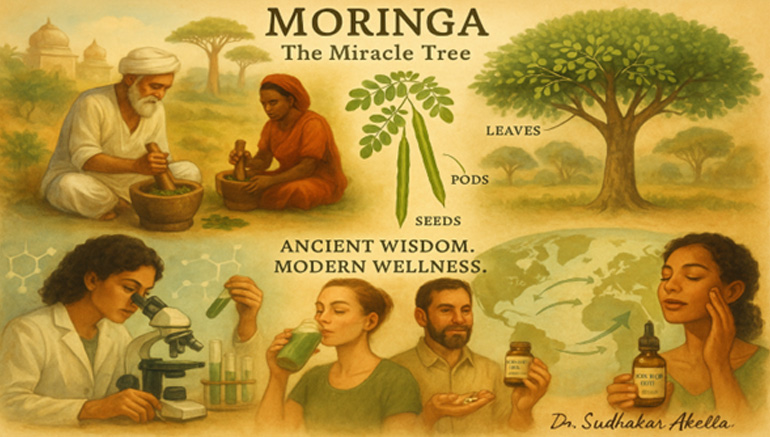Moringa: The Miracle Tree Backed by Science and Tradition

Introduction
In the world of superfoods, few ingredients have garnered as much attention as Moringa oleifera — often referred to as the Miracle Tree, Drumstick Tree, or Sahjan. Long cherished in traditional medicine and now increasingly validated by modern science, Moringa has carved out a powerful niche in the health and wellness space.
This blog explores Moringa’s rich traditional heritage, its scientifically supported health benefits, its role in nutraceutical formulations, and the growing market potential it holds for the future.
1. Traditional Uses of Moringa Across Cultures
Moringa has been used for centuries in Ayurvedic and folk medicine systems across India, Africa, and Southeast Asia. Ancient healers believed it could prevent over 300 diseases — and while that number might seem exaggerated today, it reflects Moringa’s deep-rooted medicinal significance.
Every part of the tree — from its leaves, seeds, and pods to bark and roots — has been employed for different therapeutic purposes:
- Leaves were consumed as a nutritional booster, especially for malnourished children.
- Seeds and oil were used to purify water and treat skin ailments.
- Pods (drumsticks) found their way into culinary traditions, valued for their taste and health-enhancing qualities.
2. Science-Backed Health Benefits of Moringa
Modern research has confirmed many of Moringa’s traditional uses, highlighting its status as a nutrient-dense, multifunctional botanical.
Key scientifically validated benefits include:
- Rich Nutritional Profile: Packed with vitamin A, C, E, calcium, potassium, iron, and all nine essential amino acids.
- Powerful Antioxidant: Contains quercetin, chlorogenic acid, and beta-carotene which fight oxidative stress.
- Anti-Inflammatory Effects: Suppresses inflammation-related markers like TNF-α and IL-6.
- Supports Blood Sugar Balance: Clinical studies have shown reductions in fasting blood glucose and improved insulin sensitivity.
- Cholesterol and Cardiovascular Health: Helps reduce LDL cholesterol and improve heart health markers.
- Immunity and Microbial Protection: Possesses antimicrobial and immunomodulatory effects, useful in boosting overall resilience.
3. Popular Formulations and Supplement Formats
As the interest in natural wellness surges, Moringa is being used in a variety of supplement and food formats:
- Leaf Powder: Used in capsules, tablets, teas, and even in culinary recipes like soups and smoothies.
- Moringa Oil: Rich in oleic acid, this cold-pressed oil is widely used in skincare and haircare formulations.
- Functional Foods & Beverages: Found in protein bars, herbal elixirs, green powders, and nutritional drinks.
- Fermented or Enhanced Extracts: For better bioavailability and synergy with adaptogens like Ashwagandha and Turmeric.
Its versatility makes it a formulator’s favorite — whether targeting immunity, detox, beauty, or energy.
4. Market Trends, Consumer Demand & Future Scope
Moringa is no longer just a traditional remedy — It is a trending superfood.
Global Market Trends:
- The global moringa market is projected to surpass $10 billion by 2030, driven by demand for natural and plant-based nutrition.
- Consumers now seek clean-label, sustainable, and traceable ingredients — and Moringa fits perfectly into this narrative.
Emerging segments:
- Beauty-from-within supplements
- Sports nutrition and endurance blends
- Functional herbal teas
- Plant-based prenatal nutrition
Challenges for formulators include taste masking, standardization of actives (like polyphenols or glucosinolates), and ensuring consistent supply chain quality.
Conclusion
Moringa isn’t just a fleeting trend — it’s a well-studied botanical with ancient wisdom and modern relevance. From supporting immune health and managing inflammation to offering a complete nutritional profile, it continues to earn its title as the Miracle Tree.
As science catches up with tradition, the future of Moringa in nutraceuticals, functional foods, and natural wellness looks brighter than ever.

